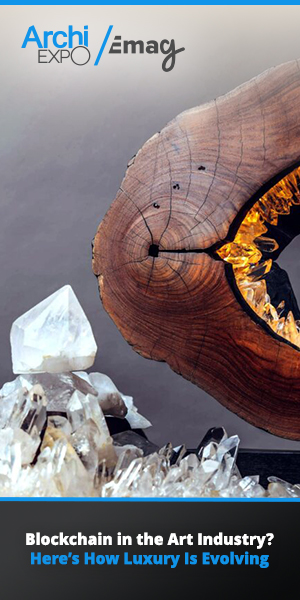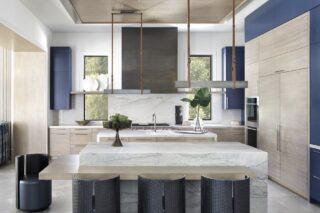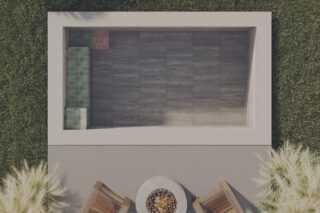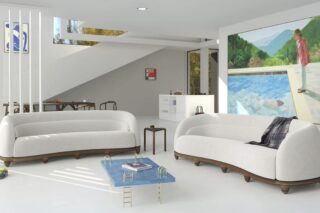Clay, a timeless material, continues to bridge tradition and innovation, as seen in HDsurface’s Argille, which transforms historic spaces like Masseria Salamina with sustainable, textured designs.
Clay has been a constant in architecture, quietly underpinning human habitation for thousands of years. From ancient adobe structures to contemporary finishes, it is a material that evolves with the times without ever truly disappearing. Recently, clay has taken on new significance in architectural innovation, as seen in the restoration of the historic Masseria Salamina in Puglia, Italy.
The project, led by HDsurface, introduced a modern application of clay to revitalize the interiors of the 17th-century structure. Using their Argille product, the design team achieved a remarkable synthesis of tradition and modernity. Argille, a natural trowelled coating, transformed the masseria’s walls and ceilings with its earthy tones and textured surfaces. Composed of clay, natural lime, plant cellulose fibers, and micronized marble powders, it brought warmth and depth to the space while honoring the building’s historic character.
This approach to clay reflects a growing trend toward natural, sustainable materials in both contemporary and restoration architecture. Unlike synthetic finishes, Argille interacts dynamically with its environment, regulating indoor humidity and temperature naturally.
“It’s not just a finish,” explains HDsurface. “It’s a continuation of the building’s story, expressed through texture and light.”
The project demonstrates clay’s enduring versatility and its potential to meet modern design standards without sacrificing its timeless appeal. While Masseria Salamina represents a modern application of clay, it is part of a larger narrative where the material has consistently been adapted to meet changing needs.
Rather than framing it as a revival, the use of clay in such projects highlights its ability to bridge past and present seamlessly. Clay is not simply a relic but a foundation for innovation, proving that timeless materials can still lead the way in architectural creativity.


Challenges in Conservation: Clay’s Dual Nature
Clay, as a material, embodies both promise and challenges in architecture. Its durability and ability to regulate temperature have made it indispensable throughout history, but its susceptibility to environmental stress has equally posed difficulties. The Alhambra fortress in Spain provides a compelling case study of clay’s strengths and vulnerabilities.
The iconic structure, a testament to Nasrid architecture, relies heavily on clay-rich materials in its construction. Yet, these very materials require constant maintenance. Environmental changes cause swelling and shrinkage in clay, leading to cracks and material loss. Recent studies highlight the difficulty in addressing these issues through conservation treatments. For example, ethyl silicate—a common consolidant—improves surface strength but does not prevent clay’s swelling, limiting its long-term efficacy.
Emerging technologies offer some hope. Nanotechnologies, such as nanosilica and nanolime, and experimental methods like bacterial biomineralization have shown promise in enhancing clay’s resilience. These treatments aim to improve weathering resistance and reduce moisture-related stresses. However, their application remains limited by factors such as poor penetration and inconsistent performance in real-world settings.
What makes clay unique as a material also complicates its preservation. Its responsiveness to moisture, while beneficial in regulating indoor climates, can be detrimental over time without proper care. Experts argue that more emphasis should be placed on managing these natural characteristics rather than trying to eliminate them.
Conservationists working on the Alhambra are at the forefront of these challenges, using innovative approaches to balance preservation with clay’s inherent properties. Their work underscores the delicate equilibrium required when dealing with such a dynamic material. Clay’s dual nature—as both a resilient and fragile material—remains central to discussions of its use, whether in conserving historic landmarks or reimagining it for modern construction.


Argille: Crafting the Future of Clay Design
In modern design, few materials marry functionality and artistry as elegantly as HDsurface’s Argille. This innovative clay-based coating has garnered attention for its role in restoring Masseria Salamina, where it reinvented the interiors of a historic masseria in Italy’s Puglia region. Its unique composition and tactile qualities make it a standout in contemporary architecture.
Argille is more than just a finish; it’s an expression of craftsmanship. Made from a blend of clay, plant cellulose fibers, natural lime, and marble powders, the coating is designed to interact dynamically with its environment. Its irregular, textured surface captures light in soft, warm reflections, while its breathable composition helps regulate humidity and temperature. This makes it as practical as it is beautiful.
The application of Argille in Masseria Salamina exemplifies its versatility. Used on the vaulted ceilings and walls, its earthy tones harmonize with the building’s historical essence while adding a contemporary touch. The material bridges past and present, enhancing the space without overshadowing its rich heritage.
“Argille allowed us to stay true to the building’s story while introducing a modern sensibility,” said the project’s designers.
Sustainability is at the heart of Argille’s appeal. In an era of growing environmental awareness, its natural components align with the movement toward eco-conscious building practices. Its production and application require minimal processing, reducing the carbon footprint compared to synthetic alternatives.
HDsurface’s Argille stands as a testament to how timeless materials like clay can continue to evolve. Its success at Masseria Salamina demonstrates the potential for clay to remain relevant in the future of architecture, not as a relic of the past but as a material of endless possibilities. As interest in natural and sustainable design grows, Argille offers a blueprint for integrating heritage and innovation seamlessly.










